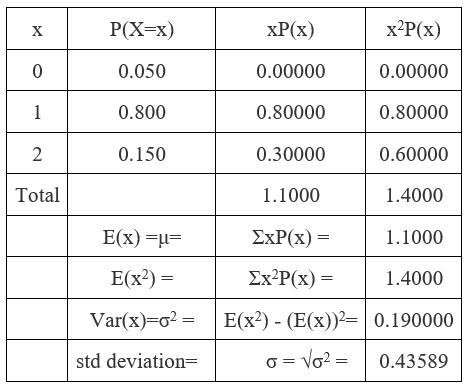For a customer, the number of books he buys in a bookstore can be treated as a random variable. The probability of not buying any book, buying one book and buying 2 books are 0.05,0.8 and 0.15 for each customer. Suggest there are 400 customers who come to this bookstore today and the number of books purchased by each customer are a sequence of iid random variables. (a) Find the probability that the bookstore could sell more than 450 books (the sum of all customers buying) today.(Hint: use central limit theorem)
For a customer, the number of books he buys in a bookstore can be treated as a random variable. The probability of not buying any book, buying one book and buying 2 books are 0.05,0.8 and 0.15 for each customer. Suggest there are 400 customers who come to this bookstore today and the number of books purchased by each customer are a sequence of iid random variables. (a) Find the probability that the bookstore could sell more than 450 books (the sum of all customers buying) today.(Hint: use central limit theorem)
A First Course in Probability (10th Edition)
10th Edition
ISBN:9780134753119
Author:Sheldon Ross
Publisher:Sheldon Ross
Chapter1: Combinatorial Analysis
Section: Chapter Questions
Problem 1.1P: a. How many different 7-place license plates are possible if the first 2 places are for letters and...
Related questions
Concept explainers
Contingency Table
A contingency table can be defined as the visual representation of the relationship between two or more categorical variables that can be evaluated and registered. It is a categorical version of the scatterplot, which is used to investigate the linear relationship between two variables. A contingency table is indeed a type of frequency distribution table that displays two variables at the same time.
Binomial Distribution
Binomial is an algebraic expression of the sum or the difference of two terms. Before knowing about binomial distribution, we must know about the binomial theorem.
Topic Video
Question

Transcribed Image Text:For a customer, the number of books he buys in a bookstore can be treated as a random variable. The
probability of not buying any book, buying one book and buying 2 books are 0.05,0.8 and 0.15 for each
customer. Suggest there are 400 customers who come to this bookstore today and the number of books
purchased by each customer are a sequence of iid random variables.
(a) Find the probability that the bookstore could sell more than 450 books (the sum of all customers buying)
today.(Hint: use central limit theorem)
Expert Solution
Step 1
According to the provided data, the mean and standard deviation for each customer is,

Step by step
Solved in 2 steps with 2 images

Knowledge Booster
Learn more about
Need a deep-dive on the concept behind this application? Look no further. Learn more about this topic, probability and related others by exploring similar questions and additional content below.Recommended textbooks for you

A First Course in Probability (10th Edition)
Probability
ISBN:
9780134753119
Author:
Sheldon Ross
Publisher:
PEARSON


A First Course in Probability (10th Edition)
Probability
ISBN:
9780134753119
Author:
Sheldon Ross
Publisher:
PEARSON
